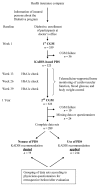Translation of personalized decision support into routine diabetes care
- PMID: 21129352
- PMCID: PMC3005067
- DOI: 10.1177/193229681000400631
Translation of personalized decision support into routine diabetes care
Abstract
Objective: The aim of this study was to evaluate the impact of personalized decision support (PDS) on metabolic control in people with diabetes and cardiovascular disease.
Research design and methods: The German health insurance fund BKK TAUNUS offers to its insured people with diabetes and cardiovascular disease the possibility to participate in the Diabetiva® program, which includes PDS. Personalized decision support is generated by the expert system KADIS® using self-control data and continuous glucose monitoring (CGM) as its data source. The physician of the participating person receives the PDS once a year, decides about use or nonuse, and reports his/her decision in a questionnaire. Metabolic control of participants treated by use or nonuse of PDS for one year and receiving CGM twice was analyzed in a retrospective observational study. The primary outcome was hemoglobin A1c (HbA1c); secondary outcomes were mean sensor glucose (MSG), glucose variability, and hypoglycemia.
Results: A total of 323 subjects received CGM twice, 289 had complete data sets, 97% (280/289) were type 2 diabetes patients, and 74% (214/289) were treated using PDS, resulting in a decrease in HbA1c [7.10±1.06 to 6.73±0.82%; p<.01; change in HbA1ct0-t12 months -0.37 (95% confidence interval -0.46 to -0.28)] and MSG (7.7±1.6 versus 7.4±1.2 mmol/liter; p=.003) within one year. Glucose variability was also reduced, as indicated by lower high blood glucose index (p=.001), Glycemic Risk Assessment Diabetes Equation (p=.009), and time of hyper-glycemia (p=.003). Low blood glucose index and time spent in hypoglycemia were not affected. In contrast, nonuse of PDS (75/289) resulted in increased HbA1c (p<.001). Diabetiva outcome was strongly related to baseline HbA1c (HbA1ct0; p<.01) and use of PDS (p<.01). Acceptance of PDS was dependent on HbA1ct0 (p=.049).
Conclusions: Personalized decision support has potential to improve metabolic outcome in routine diabetes care.
© 2010 Diabetes Technology Society.
Figures



Similar articles
-
The Karlsburg Diabetes Management System: translation from research to eHealth application.J Diabetes Sci Technol. 2011 Jan 1;5(1):13-22. doi: 10.1177/193229681100500103. J Diabetes Sci Technol. 2011. PMID: 21303620 Free PMC article.
-
Association of Real-time Continuous Glucose Monitoring With Glycemic Control and Acute Metabolic Events Among Patients With Insulin-Treated Diabetes.JAMA. 2021 Jun 8;325(22):2273-2284. doi: 10.1001/jama.2021.6530. JAMA. 2021. PMID: 34077502 Free PMC article.
-
Impact on Diabetes Self-Management and Glycemic Control of a New Color-Based SMBG Meter.J Diabetes Sci Technol. 2017 Nov;11(6):1218-1225. doi: 10.1177/1932296817706376. Epub 2017 Apr 26. J Diabetes Sci Technol. 2017. PMID: 28443343 Free PMC article.
-
Personal continuous glucose monitoring (CGM) in diabetes management: review of the literature and implementation for practical use.Diabetes Res Clin Pract. 2012 Jun;96(3):294-305. doi: 10.1016/j.diabres.2011.12.010. Epub 2011 Dec 28. Diabetes Res Clin Pract. 2012. PMID: 22209014 Review.
-
Glycemic Targets in Diabetes Care: Emerging Clarity after Accord.Trans Am Clin Climatol Assoc. 2015;126:62-76. Trans Am Clin Climatol Assoc. 2015. PMID: 26330660 Free PMC article. Review.
Cited by
-
Patient-Tailored Decision Support System Improves Short- and Long-Term Glycemic Control in Type 2 Diabetes.J Diabetes Sci Technol. 2022 Sep;16(5):1159-1166. doi: 10.1177/19322968211008871. Epub 2021 May 18. J Diabetes Sci Technol. 2022. PMID: 34000840 Free PMC article.
-
A dashboard-based system for supporting diabetes care.J Am Med Inform Assoc. 2018 May 1;25(5):538-547. doi: 10.1093/jamia/ocx159. J Am Med Inform Assoc. 2018. PMID: 29409033 Free PMC article.
-
Artificial Intelligence in Decision Support Systems for Type 1 Diabetes.Sensors (Basel). 2020 Jun 5;20(11):3214. doi: 10.3390/s20113214. Sensors (Basel). 2020. PMID: 32517068 Free PMC article. Review.
-
Q-Score: development of a new metric for continuous glucose monitoring that enables stratification of antihyperglycaemic therapies.BMC Endocr Disord. 2015 May 1;15:22. doi: 10.1186/s12902-015-0019-0. BMC Endocr Disord. 2015. PMID: 25929322 Free PMC article.
-
The intelligent diabetes telemonitoring using decision support to treat patients on insulin therapy (DiaTRUST) trial: study protocol for a randomized controlled trial.Trials. 2024 Nov 8;25(1):744. doi: 10.1186/s13063-024-08588-7. Trials. 2024. PMID: 39511648 Free PMC article.
References
-
- Augstein P, Vogt L, Kohnert KD, Freyse EJ, Heinke P, Salzsieder E. Outpatient assessment of Karlsburg Diabetes Management System-based decision support. Diabetes Care. 2007;30(7):1704–1708. - PubMed
-
- Rutscher A, Salzsieder E, Thierbach U, Fischer U, Albrecht G. KADIS—a computer-aided decision support system for improving the management of type-I diabetes. Exp Clin Endocrinol. 1990;95(1):137–147. - PubMed
-
- Birati EY, Malov N, Kogan Y, Yanay Y, Tamari M, Elizur M, Steinberg DM, Golovner M, Roth A. Vigilance, awareness and a phone line: 20 years of expediting CPR for enhancing survival after out-of-hospital cardiac arrest The ‘SHL’-Telemedicine experience in Israel. Resuscitation. 2008;79(3):438–443. - PubMed
Publication types
MeSH terms
Substances
LinkOut - more resources
Full Text Sources
Medical
Miscellaneous

